Operations Management Report: Vodafone's Scheduling, Layout, Inventory
VerifiedAdded on 2023/01/12
|10
|3718
|3
Report
AI Summary
This report provides a comprehensive analysis of operations management principles, focusing on scheduling techniques, layout planning, and inventory management, with Vodafone as a case study. The introduction defines these key concepts, setting the stage for a detailed examination of variou...
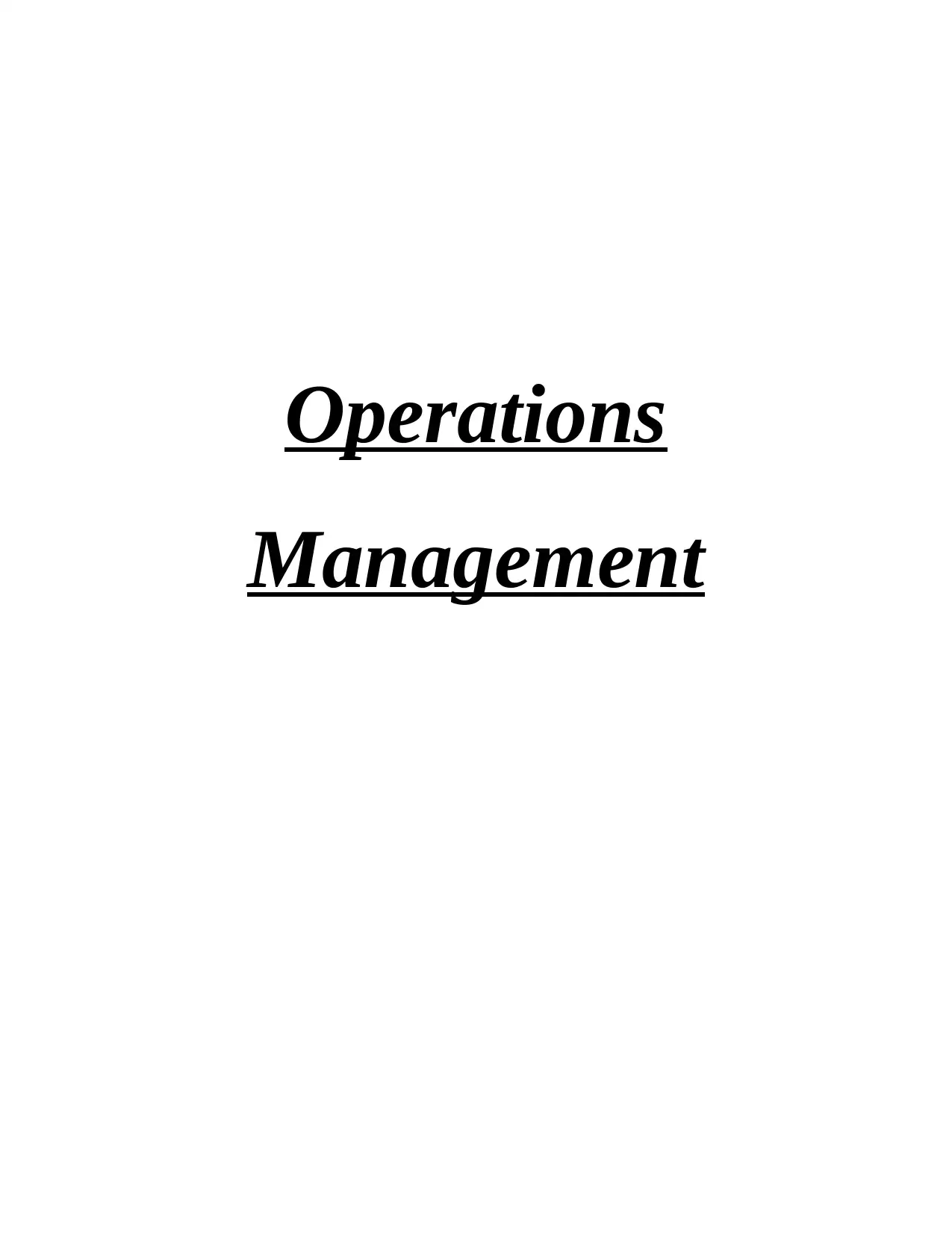
Operations
Management
Management
Paraphrase This Document
Need a fresh take? Get an instant paraphrase of this document with our AI Paraphraser
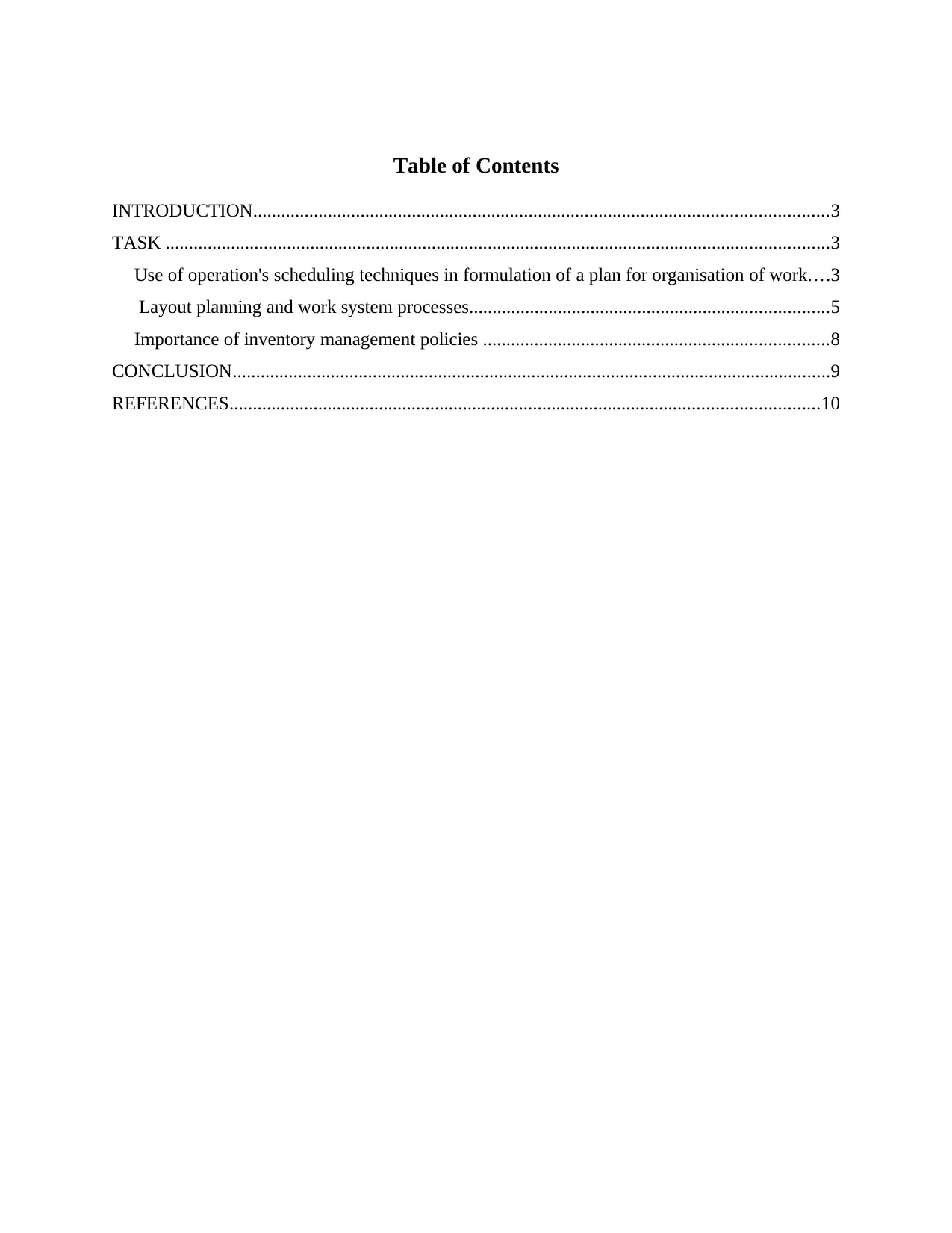
Table of Contents
INTRODUCTION...........................................................................................................................3
TASK ..............................................................................................................................................3
Use of operation's scheduling techniques in formulation of a plan for organisation of work....3
Layout planning and work system processes.............................................................................5
Importance of inventory management policies ..........................................................................8
CONCLUSION................................................................................................................................9
REFERENCES..............................................................................................................................10
INTRODUCTION...........................................................................................................................3
TASK ..............................................................................................................................................3
Use of operation's scheduling techniques in formulation of a plan for organisation of work....3
Layout planning and work system processes.............................................................................5
Importance of inventory management policies ..........................................................................8
CONCLUSION................................................................................................................................9
REFERENCES..............................................................................................................................10
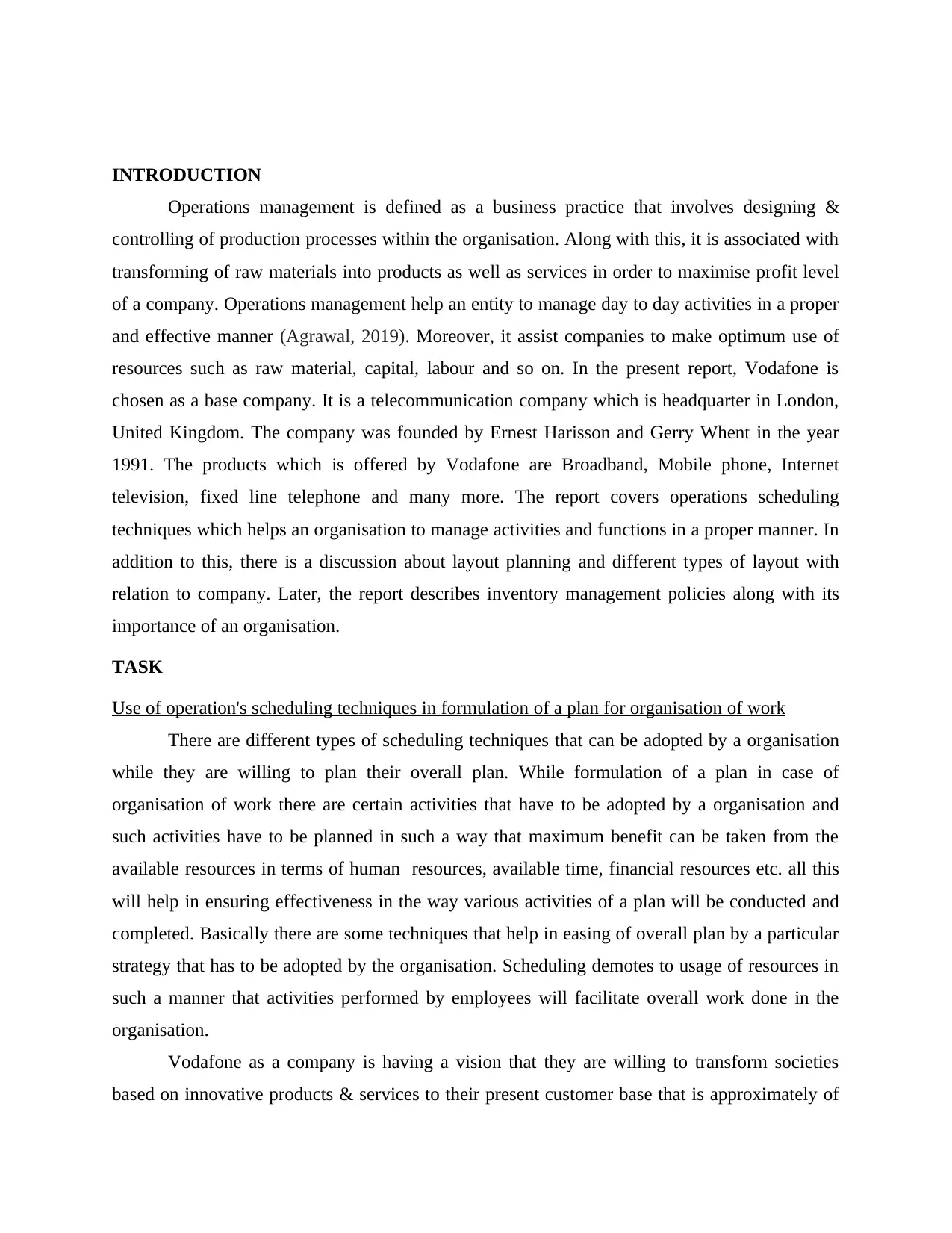
INTRODUCTION
Operations management is defined as a business practice that involves designing &
controlling of production processes within the organisation. Along with this, it is associated with
transforming of raw materials into products as well as services in order to maximise profit level
of a company. Operations management help an entity to manage day to day activities in a proper
and effective manner (Agrawal, 2019). Moreover, it assist companies to make optimum use of
resources such as raw material, capital, labour and so on. In the present report, Vodafone is
chosen as a base company. It is a telecommunication company which is headquarter in London,
United Kingdom. The company was founded by Ernest Harisson and Gerry Whent in the year
1991. The products which is offered by Vodafone are Broadband, Mobile phone, Internet
television, fixed line telephone and many more. The report covers operations scheduling
techniques which helps an organisation to manage activities and functions in a proper manner. In
addition to this, there is a discussion about layout planning and different types of layout with
relation to company. Later, the report describes inventory management policies along with its
importance of an organisation.
TASK
Use of operation's scheduling techniques in formulation of a plan for organisation of work
There are different types of scheduling techniques that can be adopted by a organisation
while they are willing to plan their overall plan. While formulation of a plan in case of
organisation of work there are certain activities that have to be adopted by a organisation and
such activities have to be planned in such a way that maximum benefit can be taken from the
available resources in terms of human resources, available time, financial resources etc. all this
will help in ensuring effectiveness in the way various activities of a plan will be conducted and
completed. Basically there are some techniques that help in easing of overall plan by a particular
strategy that has to be adopted by the organisation. Scheduling demotes to usage of resources in
such a manner that activities performed by employees will facilitate overall work done in the
organisation.
Vodafone as a company is having a vision that they are willing to transform societies
based on innovative products & services to their present customer base that is approximately of
Operations management is defined as a business practice that involves designing &
controlling of production processes within the organisation. Along with this, it is associated with
transforming of raw materials into products as well as services in order to maximise profit level
of a company. Operations management help an entity to manage day to day activities in a proper
and effective manner (Agrawal, 2019). Moreover, it assist companies to make optimum use of
resources such as raw material, capital, labour and so on. In the present report, Vodafone is
chosen as a base company. It is a telecommunication company which is headquarter in London,
United Kingdom. The company was founded by Ernest Harisson and Gerry Whent in the year
1991. The products which is offered by Vodafone are Broadband, Mobile phone, Internet
television, fixed line telephone and many more. The report covers operations scheduling
techniques which helps an organisation to manage activities and functions in a proper manner. In
addition to this, there is a discussion about layout planning and different types of layout with
relation to company. Later, the report describes inventory management policies along with its
importance of an organisation.
TASK
Use of operation's scheduling techniques in formulation of a plan for organisation of work
There are different types of scheduling techniques that can be adopted by a organisation
while they are willing to plan their overall plan. While formulation of a plan in case of
organisation of work there are certain activities that have to be adopted by a organisation and
such activities have to be planned in such a way that maximum benefit can be taken from the
available resources in terms of human resources, available time, financial resources etc. all this
will help in ensuring effectiveness in the way various activities of a plan will be conducted and
completed. Basically there are some techniques that help in easing of overall plan by a particular
strategy that has to be adopted by the organisation. Scheduling demotes to usage of resources in
such a manner that activities performed by employees will facilitate overall work done in the
organisation.
Vodafone as a company is having a vision that they are willing to transform societies
based on innovative products & services to their present customer base that is approximately of
⊘ This is a preview!⊘
Do you want full access?
Subscribe today to unlock all pages.

Trusted by 1+ million students worldwide

404 million and 68 percent of this is coming from their emerging markets (Agrifoglio, 2017).
There are some issues such as location of facility and plant & equipment have to be considered
for long term planning.
a) First come first serve: This is a technique of scheduling in which one item has to be
served that is produced. In this the organisation is concern with as soon as customer is making
order of a product. It is a very effective tool in case of single product. In case if a organisation is
having many different type of products then this approach cannot be effectively used. Vodafone
is a organisation that has established their successful brand image by serving their customers as
soon as they make a order in terms of a plan or any other service that they are willing to avail
from a organisation.
b) Shortest processing time: This is also one of very popular approaches of scheduling .
This is a procedure that consist of direction of products on the minimum time period. It will help
in keeping that functions in priority that are taking less amount of time in completion. The
overall lost time that is related with switching from one job to another is reduced and minimized
while formulation of plan (Choi, Wallace and Wang, 2018). Also, there is lot of time that is
wasted while switching between different machineries by employees. The overall time is saved if
short processing time is used by employees.
c) Earliest due date: This also a scheduling technique that can be used for formulation
of process by organisation in which overall process of production is based on various deadlines
of work. In this technique the project that is having its first due date has to be completed first and
priority is set based on allotted deadline of work. This approach is usually applied by those
organisation that are having only one product and they posses diverse deadline for shipping of
their product as there has to be effectiveness set with the machines also. Machines are mostly
effective in case of singular products are produced. In this technique Vodafone have to plan the
production if those activities first that have a due date. This is a little complex for a organisation
such as Vodafone that already posses lot of category of products and services and there is no
single product that is being offered by this company.
D) Slack time remaining: slack time is the item that is left for a job has been started.
This is a very common system that is used in case there are multiple processors (de Sousa
Jabbour, 2018). In this technique of operations management those processes that posses least
“slack time” are selected first. Slack time is basically difference between run time and ready
There are some issues such as location of facility and plant & equipment have to be considered
for long term planning.
a) First come first serve: This is a technique of scheduling in which one item has to be
served that is produced. In this the organisation is concern with as soon as customer is making
order of a product. It is a very effective tool in case of single product. In case if a organisation is
having many different type of products then this approach cannot be effectively used. Vodafone
is a organisation that has established their successful brand image by serving their customers as
soon as they make a order in terms of a plan or any other service that they are willing to avail
from a organisation.
b) Shortest processing time: This is also one of very popular approaches of scheduling .
This is a procedure that consist of direction of products on the minimum time period. It will help
in keeping that functions in priority that are taking less amount of time in completion. The
overall lost time that is related with switching from one job to another is reduced and minimized
while formulation of plan (Choi, Wallace and Wang, 2018). Also, there is lot of time that is
wasted while switching between different machineries by employees. The overall time is saved if
short processing time is used by employees.
c) Earliest due date: This also a scheduling technique that can be used for formulation
of process by organisation in which overall process of production is based on various deadlines
of work. In this technique the project that is having its first due date has to be completed first and
priority is set based on allotted deadline of work. This approach is usually applied by those
organisation that are having only one product and they posses diverse deadline for shipping of
their product as there has to be effectiveness set with the machines also. Machines are mostly
effective in case of singular products are produced. In this technique Vodafone have to plan the
production if those activities first that have a due date. This is a little complex for a organisation
such as Vodafone that already posses lot of category of products and services and there is no
single product that is being offered by this company.
D) Slack time remaining: slack time is the item that is left for a job has been started.
This is a very common system that is used in case there are multiple processors (de Sousa
Jabbour, 2018). In this technique of operations management those processes that posses least
“slack time” are selected first. Slack time is basically difference between run time and ready
Paraphrase This Document
Need a fresh take? Get an instant paraphrase of this document with our AI Paraphraser
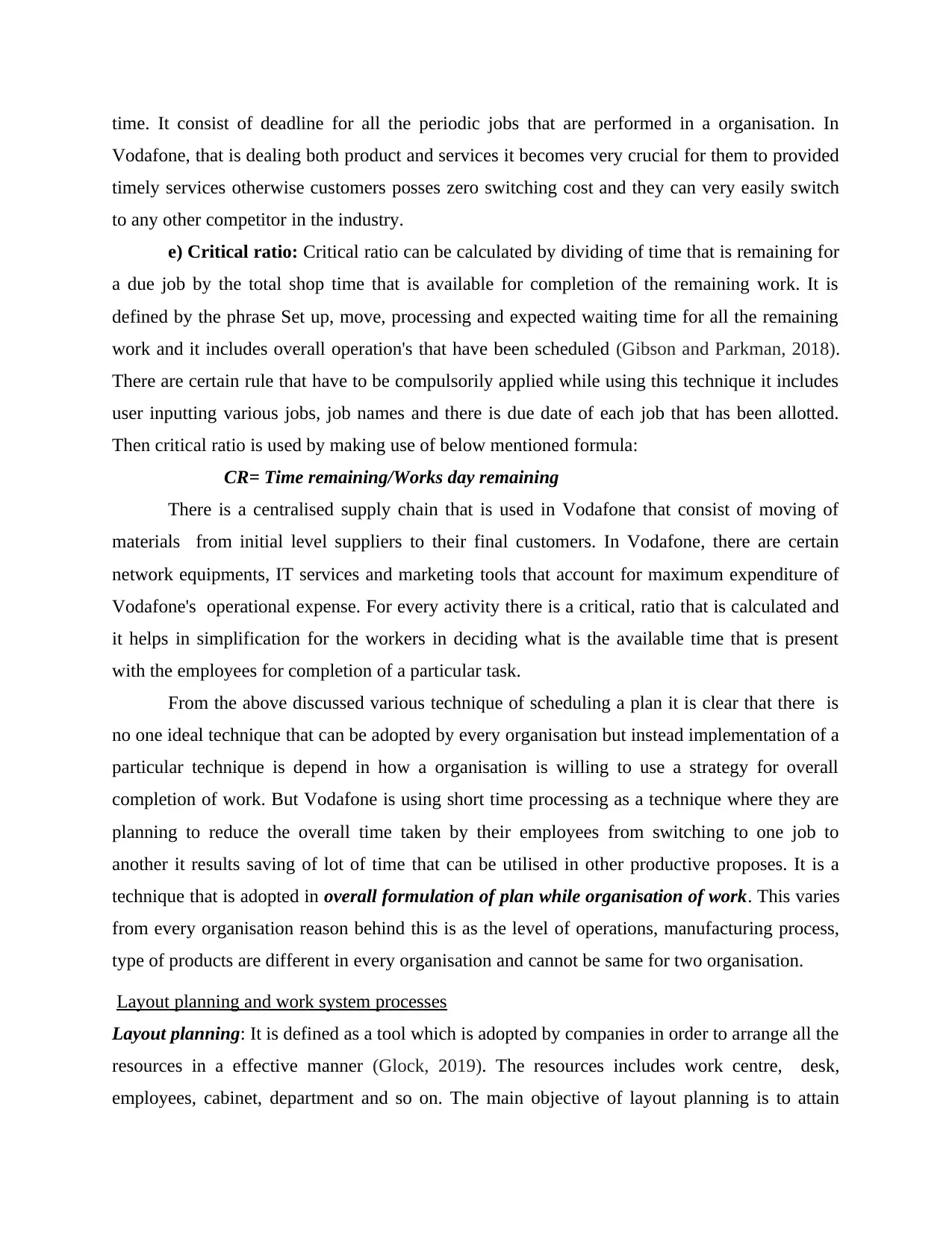
time. It consist of deadline for all the periodic jobs that are performed in a organisation. In
Vodafone, that is dealing both product and services it becomes very crucial for them to provided
timely services otherwise customers posses zero switching cost and they can very easily switch
to any other competitor in the industry.
e) Critical ratio: Critical ratio can be calculated by dividing of time that is remaining for
a due job by the total shop time that is available for completion of the remaining work. It is
defined by the phrase Set up, move, processing and expected waiting time for all the remaining
work and it includes overall operation's that have been scheduled (Gibson and Parkman, 2018).
There are certain rule that have to be compulsorily applied while using this technique it includes
user inputting various jobs, job names and there is due date of each job that has been allotted.
Then critical ratio is used by making use of below mentioned formula:
CR= Time remaining/Works day remaining
There is a centralised supply chain that is used in Vodafone that consist of moving of
materials from initial level suppliers to their final customers. In Vodafone, there are certain
network equipments, IT services and marketing tools that account for maximum expenditure of
Vodafone's operational expense. For every activity there is a critical, ratio that is calculated and
it helps in simplification for the workers in deciding what is the available time that is present
with the employees for completion of a particular task.
From the above discussed various technique of scheduling a plan it is clear that there is
no one ideal technique that can be adopted by every organisation but instead implementation of a
particular technique is depend in how a organisation is willing to use a strategy for overall
completion of work. But Vodafone is using short time processing as a technique where they are
planning to reduce the overall time taken by their employees from switching to one job to
another it results saving of lot of time that can be utilised in other productive proposes. It is a
technique that is adopted in overall formulation of plan while organisation of work. This varies
from every organisation reason behind this is as the level of operations, manufacturing process,
type of products are different in every organisation and cannot be same for two organisation.
Layout planning and work system processes
Layout planning: It is defined as a tool which is adopted by companies in order to arrange all the
resources in a effective manner (Glock, 2019). The resources includes work centre, desk,
employees, cabinet, department and so on. The main objective of layout planning is to attain
Vodafone, that is dealing both product and services it becomes very crucial for them to provided
timely services otherwise customers posses zero switching cost and they can very easily switch
to any other competitor in the industry.
e) Critical ratio: Critical ratio can be calculated by dividing of time that is remaining for
a due job by the total shop time that is available for completion of the remaining work. It is
defined by the phrase Set up, move, processing and expected waiting time for all the remaining
work and it includes overall operation's that have been scheduled (Gibson and Parkman, 2018).
There are certain rule that have to be compulsorily applied while using this technique it includes
user inputting various jobs, job names and there is due date of each job that has been allotted.
Then critical ratio is used by making use of below mentioned formula:
CR= Time remaining/Works day remaining
There is a centralised supply chain that is used in Vodafone that consist of moving of
materials from initial level suppliers to their final customers. In Vodafone, there are certain
network equipments, IT services and marketing tools that account for maximum expenditure of
Vodafone's operational expense. For every activity there is a critical, ratio that is calculated and
it helps in simplification for the workers in deciding what is the available time that is present
with the employees for completion of a particular task.
From the above discussed various technique of scheduling a plan it is clear that there is
no one ideal technique that can be adopted by every organisation but instead implementation of a
particular technique is depend in how a organisation is willing to use a strategy for overall
completion of work. But Vodafone is using short time processing as a technique where they are
planning to reduce the overall time taken by their employees from switching to one job to
another it results saving of lot of time that can be utilised in other productive proposes. It is a
technique that is adopted in overall formulation of plan while organisation of work. This varies
from every organisation reason behind this is as the level of operations, manufacturing process,
type of products are different in every organisation and cannot be same for two organisation.
Layout planning and work system processes
Layout planning: It is defined as a tool which is adopted by companies in order to arrange all the
resources in a effective manner (Glock, 2019). The resources includes work centre, desk,
employees, cabinet, department and so on. The main objective of layout planning is to attain

economies in handling of finished goods, raw materials and work-in- progress. There are
basically four types of layout that is process, hybrid, fixed position and product layout as well.
These layouts are defined below:
Process layout: These type of layout involves all the resources which is of similar
functions and processes. In addition to this, all the machines that perform same operations is
grouped at a single location in a proper manner. This type of layout requires less investment and
acquire less time of managers of an organisation. One of the main advantage is proper utilisation
of resources and production facilities that leads to increases in performance of a company. It is
determined that breakdown of single machine and equipment did not result in stoppage of
activities as well a work. Process layout is suitable where manufactured products are non
standardised and production does not take place at large scale.
Combination Layout: It involves both type of layout that is even process layout and
product layout. In general, it includes two forms of layout and is used by companies as per their
advantage and benefits. For instance, manufacturing company of refrigerator uses combination
layout in its processes. This type of layout is suitable for those companies where products is
develop in different size as well as types. In order to adopt Combination layout, it is important
for companies to maintain sequence of operations similar with goods & sizes.
Product layout: This type of layout is also known as line layout as all the machines and
equipments is arranged in a single straight line. Herein, machineries is arranged and settled in a
sequence according to the requirement of production of a product (Guha and Kumar, 2018). One
of the main advantage of product layout is it declines material handling cost due to which an
association earn higher profits. Along with this, product layout decline bottlenecks that is it
maintains perfect line balance of manufacturing cycle in an effective manner. Product layout
requires high capital investments as it involves special machines in order t complete the process
in a best manner. It is determined that breakdown of any machine within the sequence results in
stoppage of manufacturing and production process. This type of layout is suitable for those
organisations where few standardised goods are manufactured. In addition to this, it is also
suitable for those products where less inspection is needed during the sequence of operations.
Fixed position layout: Herein, raw material, machine and men are taking to a product
which remain stable at one place because of its size. Fixed position layout is also known as
stationary layout. Air craft manufacturing, construction of bridges, dams are some of the
basically four types of layout that is process, hybrid, fixed position and product layout as well.
These layouts are defined below:
Process layout: These type of layout involves all the resources which is of similar
functions and processes. In addition to this, all the machines that perform same operations is
grouped at a single location in a proper manner. This type of layout requires less investment and
acquire less time of managers of an organisation. One of the main advantage is proper utilisation
of resources and production facilities that leads to increases in performance of a company. It is
determined that breakdown of single machine and equipment did not result in stoppage of
activities as well a work. Process layout is suitable where manufactured products are non
standardised and production does not take place at large scale.
Combination Layout: It involves both type of layout that is even process layout and
product layout. In general, it includes two forms of layout and is used by companies as per their
advantage and benefits. For instance, manufacturing company of refrigerator uses combination
layout in its processes. This type of layout is suitable for those companies where products is
develop in different size as well as types. In order to adopt Combination layout, it is important
for companies to maintain sequence of operations similar with goods & sizes.
Product layout: This type of layout is also known as line layout as all the machines and
equipments is arranged in a single straight line. Herein, machineries is arranged and settled in a
sequence according to the requirement of production of a product (Guha and Kumar, 2018). One
of the main advantage of product layout is it declines material handling cost due to which an
association earn higher profits. Along with this, product layout decline bottlenecks that is it
maintains perfect line balance of manufacturing cycle in an effective manner. Product layout
requires high capital investments as it involves special machines in order t complete the process
in a best manner. It is determined that breakdown of any machine within the sequence results in
stoppage of manufacturing and production process. This type of layout is suitable for those
organisations where few standardised goods are manufactured. In addition to this, it is also
suitable for those products where less inspection is needed during the sequence of operations.
Fixed position layout: Herein, raw material, machine and men are taking to a product
which remain stable at one place because of its size. Fixed position layout is also known as
stationary layout. Air craft manufacturing, construction of bridges, dams are some of the
⊘ This is a preview!⊘
Do you want full access?
Subscribe today to unlock all pages.

Trusted by 1+ million students worldwide

example of fixed position layout. The form of layout is suitable when few heavy products is to be
manufactured & when transportation of cost is high. The advantage of using fixed layout is it
requires lower capital investment and assist in improving skills of operators.
From the above discussion, it is analysed that Vodafone is using product layout as
transformed resources ensure flow to devices in a certain sequence. In addition to this, its
operation management team sequence all the machineries in a proper manner so that outputs that
is revived should be accurate as well properly manufactured (Hill, 2017). The products which is
offered by Vodafone requires less inspection as well as its goods are standardised and this is the
reason company is adopted product layout for its manufacturing processes.
Work system processing: It is defined a an approach which is used by an organisation to work
more effectively and efficiently and to easily adopt changing environment. A system is defined
as a group of things which forms a unit in a effective manner whereas process is associated with
activities that is inside in a system and work together in o0rder to form a function. It is essential
for an organisation to emphasise on maintaining processes effective as it helps a system to run
smoothly and efficiently. Work system processing is defined as a system in which machines or
human participants perform activities by using technology, information as well as resources of a
company. There work systems are job measurement, job design, job compensation and may
more. These work system is defined below in context to company:
Job design: It is defined as a procedure of organising work into particular tasks which is
required in order to perform a job. In addition to this, it is a procedure of deciding contents of job
that includes duties & responsibilities, techniques, systems and many more. In context to
Vodafone, its human resource manager perform this system in an effective manner. It helps
company to generate interest of staff members toward their job that leads to attainment of
organisational goals within he time frame (Holweg, 2018). Moreover, job design raise
motivation & productivity that directly affect on profitability level of Vodafone in a positive
manner. Along with this, job design ensures safety working environment to employees that
develops confidence and morale of staff members due to which hey work with full potential
towards increasing profitability and attainment of desired goals within given time frame. Job
design system also assist managers of Vodafone to reduce wastage and cut down cost that
directly increases profit & revenue level of company. It is determined that job design deals with
manufactured & when transportation of cost is high. The advantage of using fixed layout is it
requires lower capital investment and assist in improving skills of operators.
From the above discussion, it is analysed that Vodafone is using product layout as
transformed resources ensure flow to devices in a certain sequence. In addition to this, its
operation management team sequence all the machineries in a proper manner so that outputs that
is revived should be accurate as well properly manufactured (Hill, 2017). The products which is
offered by Vodafone requires less inspection as well as its goods are standardised and this is the
reason company is adopted product layout for its manufacturing processes.
Work system processing: It is defined a an approach which is used by an organisation to work
more effectively and efficiently and to easily adopt changing environment. A system is defined
as a group of things which forms a unit in a effective manner whereas process is associated with
activities that is inside in a system and work together in o0rder to form a function. It is essential
for an organisation to emphasise on maintaining processes effective as it helps a system to run
smoothly and efficiently. Work system processing is defined as a system in which machines or
human participants perform activities by using technology, information as well as resources of a
company. There work systems are job measurement, job design, job compensation and may
more. These work system is defined below in context to company:
Job design: It is defined as a procedure of organising work into particular tasks which is
required in order to perform a job. In addition to this, it is a procedure of deciding contents of job
that includes duties & responsibilities, techniques, systems and many more. In context to
Vodafone, its human resource manager perform this system in an effective manner. It helps
company to generate interest of staff members toward their job that leads to attainment of
organisational goals within he time frame (Holweg, 2018). Moreover, job design raise
motivation & productivity that directly affect on profitability level of Vodafone in a positive
manner. Along with this, job design ensures safety working environment to employees that
develops confidence and morale of staff members due to which hey work with full potential
towards increasing profitability and attainment of desired goals within given time frame. Job
design system also assist managers of Vodafone to reduce wastage and cut down cost that
directly increases profit & revenue level of company. It is determined that job design deals with
Paraphrase This Document
Need a fresh take? Get an instant paraphrase of this document with our AI Paraphraser
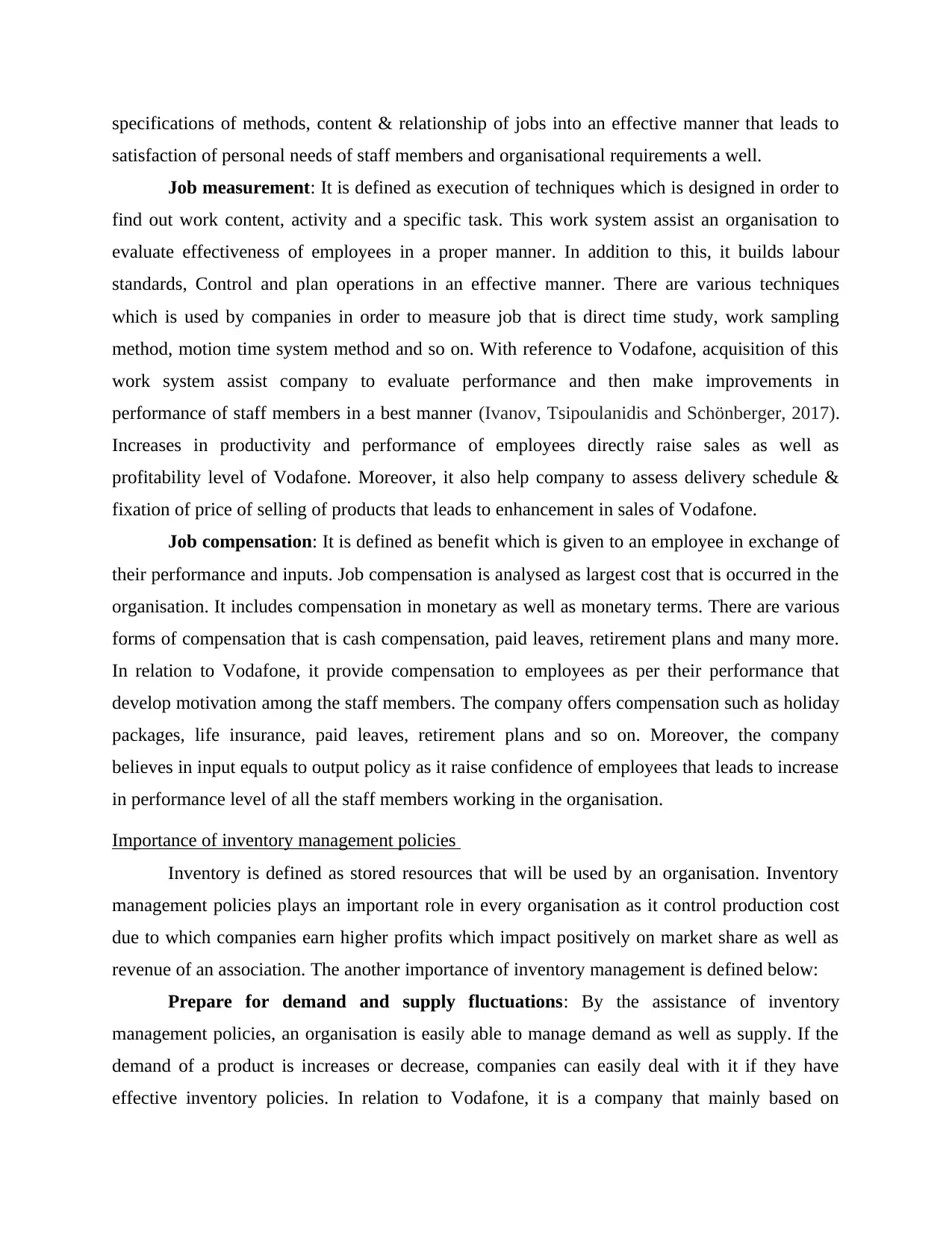
specifications of methods, content & relationship of jobs into an effective manner that leads to
satisfaction of personal needs of staff members and organisational requirements a well.
Job measurement: It is defined as execution of techniques which is designed in order to
find out work content, activity and a specific task. This work system assist an organisation to
evaluate effectiveness of employees in a proper manner. In addition to this, it builds labour
standards, Control and plan operations in an effective manner. There are various techniques
which is used by companies in order to measure job that is direct time study, work sampling
method, motion time system method and so on. With reference to Vodafone, acquisition of this
work system assist company to evaluate performance and then make improvements in
performance of staff members in a best manner (Ivanov, Tsipoulanidis and Schönberger, 2017).
Increases in productivity and performance of employees directly raise sales as well as
profitability level of Vodafone. Moreover, it also help company to assess delivery schedule &
fixation of price of selling of products that leads to enhancement in sales of Vodafone.
Job compensation: It is defined as benefit which is given to an employee in exchange of
their performance and inputs. Job compensation is analysed as largest cost that is occurred in the
organisation. It includes compensation in monetary as well as monetary terms. There are various
forms of compensation that is cash compensation, paid leaves, retirement plans and many more.
In relation to Vodafone, it provide compensation to employees as per their performance that
develop motivation among the staff members. The company offers compensation such as holiday
packages, life insurance, paid leaves, retirement plans and so on. Moreover, the company
believes in input equals to output policy as it raise confidence of employees that leads to increase
in performance level of all the staff members working in the organisation.
Importance of inventory management policies
Inventory is defined as stored resources that will be used by an organisation. Inventory
management policies plays an important role in every organisation as it control production cost
due to which companies earn higher profits which impact positively on market share as well as
revenue of an association. The another importance of inventory management is defined below:
Prepare for demand and supply fluctuations: By the assistance of inventory
management policies, an organisation is easily able to manage demand as well as supply. If the
demand of a product is increases or decrease, companies can easily deal with it if they have
effective inventory policies. In relation to Vodafone, it is a company that mainly based on
satisfaction of personal needs of staff members and organisational requirements a well.
Job measurement: It is defined as execution of techniques which is designed in order to
find out work content, activity and a specific task. This work system assist an organisation to
evaluate effectiveness of employees in a proper manner. In addition to this, it builds labour
standards, Control and plan operations in an effective manner. There are various techniques
which is used by companies in order to measure job that is direct time study, work sampling
method, motion time system method and so on. With reference to Vodafone, acquisition of this
work system assist company to evaluate performance and then make improvements in
performance of staff members in a best manner (Ivanov, Tsipoulanidis and Schönberger, 2017).
Increases in productivity and performance of employees directly raise sales as well as
profitability level of Vodafone. Moreover, it also help company to assess delivery schedule &
fixation of price of selling of products that leads to enhancement in sales of Vodafone.
Job compensation: It is defined as benefit which is given to an employee in exchange of
their performance and inputs. Job compensation is analysed as largest cost that is occurred in the
organisation. It includes compensation in monetary as well as monetary terms. There are various
forms of compensation that is cash compensation, paid leaves, retirement plans and many more.
In relation to Vodafone, it provide compensation to employees as per their performance that
develop motivation among the staff members. The company offers compensation such as holiday
packages, life insurance, paid leaves, retirement plans and so on. Moreover, the company
believes in input equals to output policy as it raise confidence of employees that leads to increase
in performance level of all the staff members working in the organisation.
Importance of inventory management policies
Inventory is defined as stored resources that will be used by an organisation. Inventory
management policies plays an important role in every organisation as it control production cost
due to which companies earn higher profits which impact positively on market share as well as
revenue of an association. The another importance of inventory management is defined below:
Prepare for demand and supply fluctuations: By the assistance of inventory
management policies, an organisation is easily able to manage demand as well as supply. If the
demand of a product is increases or decrease, companies can easily deal with it if they have
effective inventory policies. In relation to Vodafone, it is a company that mainly based on
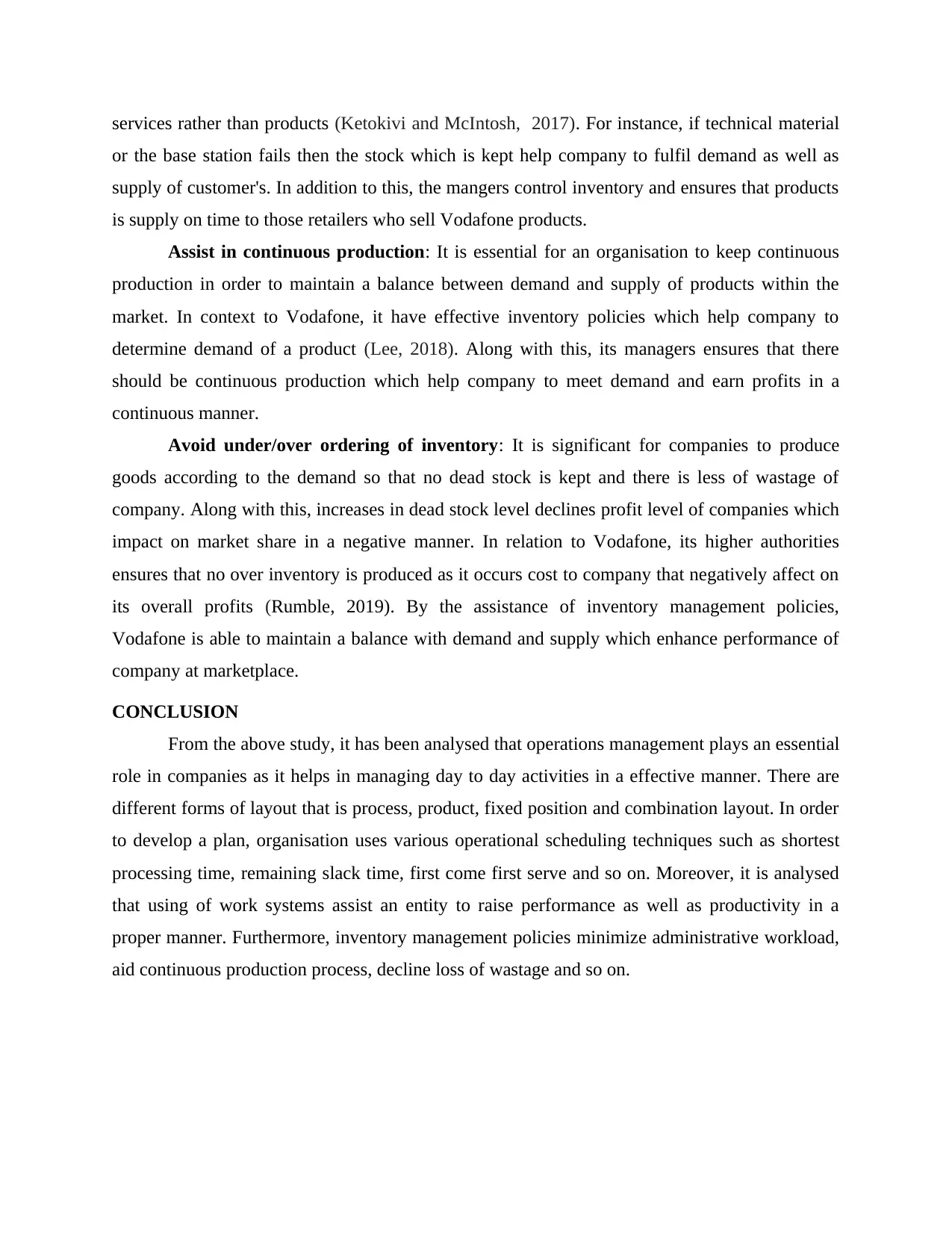
services rather than products (Ketokivi and McIntosh, 2017). For instance, if technical material
or the base station fails then the stock which is kept help company to fulfil demand as well as
supply of customer's. In addition to this, the mangers control inventory and ensures that products
is supply on time to those retailers who sell Vodafone products.
Assist in continuous production: It is essential for an organisation to keep continuous
production in order to maintain a balance between demand and supply of products within the
market. In context to Vodafone, it have effective inventory policies which help company to
determine demand of a product (Lee, 2018). Along with this, its managers ensures that there
should be continuous production which help company to meet demand and earn profits in a
continuous manner.
Avoid under/over ordering of inventory: It is significant for companies to produce
goods according to the demand so that no dead stock is kept and there is less of wastage of
company. Along with this, increases in dead stock level declines profit level of companies which
impact on market share in a negative manner. In relation to Vodafone, its higher authorities
ensures that no over inventory is produced as it occurs cost to company that negatively affect on
its overall profits (Rumble, 2019). By the assistance of inventory management policies,
Vodafone is able to maintain a balance with demand and supply which enhance performance of
company at marketplace.
CONCLUSION
From the above study, it has been analysed that operations management plays an essential
role in companies as it helps in managing day to day activities in a effective manner. There are
different forms of layout that is process, product, fixed position and combination layout. In order
to develop a plan, organisation uses various operational scheduling techniques such as shortest
processing time, remaining slack time, first come first serve and so on. Moreover, it is analysed
that using of work systems assist an entity to raise performance as well as productivity in a
proper manner. Furthermore, inventory management policies minimize administrative workload,
aid continuous production process, decline loss of wastage and so on.
or the base station fails then the stock which is kept help company to fulfil demand as well as
supply of customer's. In addition to this, the mangers control inventory and ensures that products
is supply on time to those retailers who sell Vodafone products.
Assist in continuous production: It is essential for an organisation to keep continuous
production in order to maintain a balance between demand and supply of products within the
market. In context to Vodafone, it have effective inventory policies which help company to
determine demand of a product (Lee, 2018). Along with this, its managers ensures that there
should be continuous production which help company to meet demand and earn profits in a
continuous manner.
Avoid under/over ordering of inventory: It is significant for companies to produce
goods according to the demand so that no dead stock is kept and there is less of wastage of
company. Along with this, increases in dead stock level declines profit level of companies which
impact on market share in a negative manner. In relation to Vodafone, its higher authorities
ensures that no over inventory is produced as it occurs cost to company that negatively affect on
its overall profits (Rumble, 2019). By the assistance of inventory management policies,
Vodafone is able to maintain a balance with demand and supply which enhance performance of
company at marketplace.
CONCLUSION
From the above study, it has been analysed that operations management plays an essential
role in companies as it helps in managing day to day activities in a effective manner. There are
different forms of layout that is process, product, fixed position and combination layout. In order
to develop a plan, organisation uses various operational scheduling techniques such as shortest
processing time, remaining slack time, first come first serve and so on. Moreover, it is analysed
that using of work systems assist an entity to raise performance as well as productivity in a
proper manner. Furthermore, inventory management policies minimize administrative workload,
aid continuous production process, decline loss of wastage and so on.
⊘ This is a preview!⊘
Do you want full access?
Subscribe today to unlock all pages.

Trusted by 1+ million students worldwide
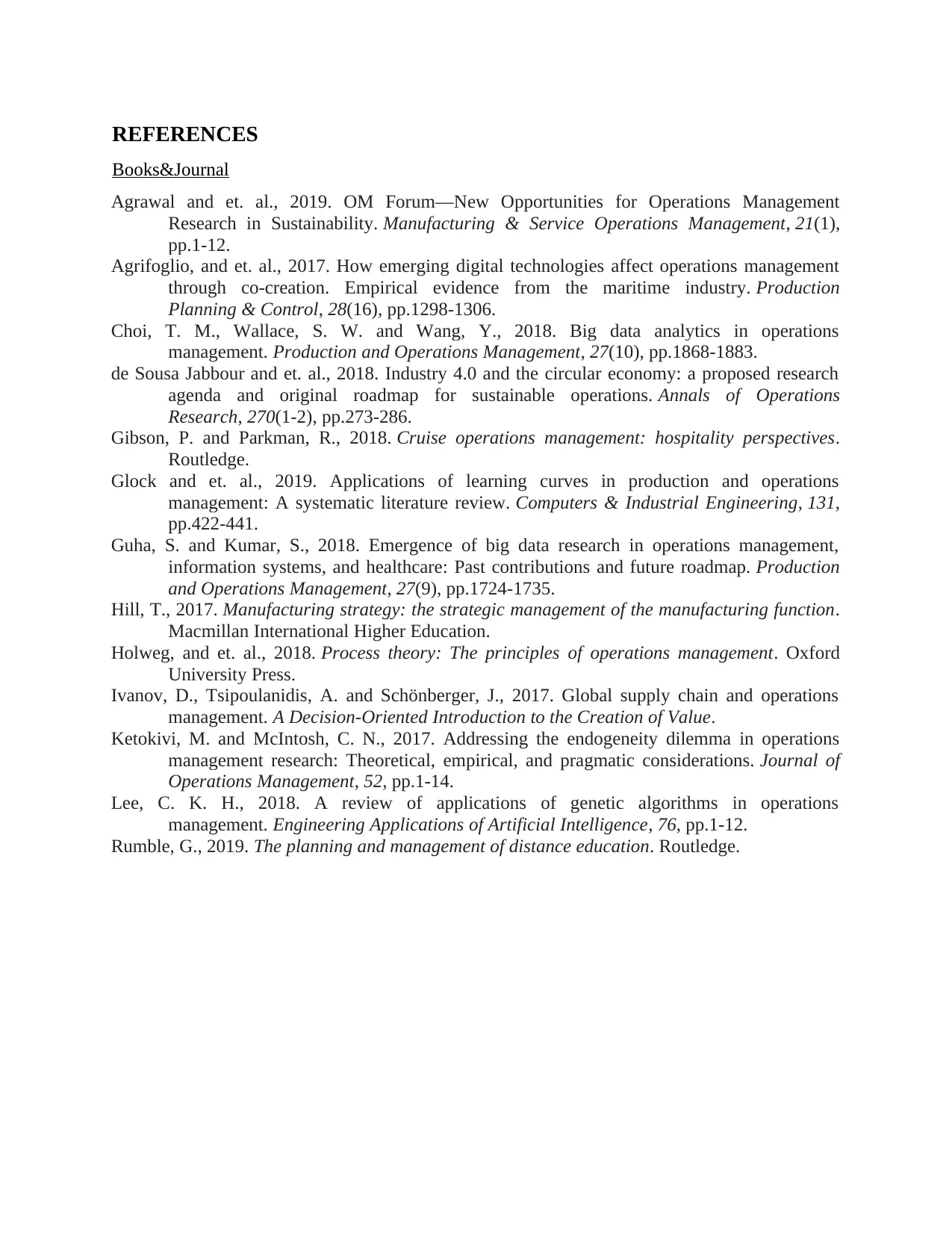
REFERENCES
Books&Journal
Agrawal and et. al., 2019. OM Forum—New Opportunities for Operations Management
Research in Sustainability. Manufacturing & Service Operations Management, 21(1),
pp.1-12.
Agrifoglio, and et. al., 2017. How emerging digital technologies affect operations management
through co-creation. Empirical evidence from the maritime industry. Production
Planning & Control, 28(16), pp.1298-1306.
Choi, T. M., Wallace, S. W. and Wang, Y., 2018. Big data analytics in operations
management. Production and Operations Management, 27(10), pp.1868-1883.
de Sousa Jabbour and et. al., 2018. Industry 4.0 and the circular economy: a proposed research
agenda and original roadmap for sustainable operations. Annals of Operations
Research, 270(1-2), pp.273-286.
Gibson, P. and Parkman, R., 2018. Cruise operations management: hospitality perspectives.
Routledge.
Glock and et. al., 2019. Applications of learning curves in production and operations
management: A systematic literature review. Computers & Industrial Engineering, 131,
pp.422-441.
Guha, S. and Kumar, S., 2018. Emergence of big data research in operations management,
information systems, and healthcare: Past contributions and future roadmap. Production
and Operations Management, 27(9), pp.1724-1735.
Hill, T., 2017. Manufacturing strategy: the strategic management of the manufacturing function.
Macmillan International Higher Education.
Holweg, and et. al., 2018. Process theory: The principles of operations management. Oxford
University Press.
Ivanov, D., Tsipoulanidis, A. and Schönberger, J., 2017. Global supply chain and operations
management. A Decision-Oriented Introduction to the Creation of Value.
Ketokivi, M. and McIntosh, C. N., 2017. Addressing the endogeneity dilemma in operations
management research: Theoretical, empirical, and pragmatic considerations. Journal of
Operations Management, 52, pp.1-14.
Lee, C. K. H., 2018. A review of applications of genetic algorithms in operations
management. Engineering Applications of Artificial Intelligence, 76, pp.1-12.
Rumble, G., 2019. The planning and management of distance education. Routledge.
Books&Journal
Agrawal and et. al., 2019. OM Forum—New Opportunities for Operations Management
Research in Sustainability. Manufacturing & Service Operations Management, 21(1),
pp.1-12.
Agrifoglio, and et. al., 2017. How emerging digital technologies affect operations management
through co-creation. Empirical evidence from the maritime industry. Production
Planning & Control, 28(16), pp.1298-1306.
Choi, T. M., Wallace, S. W. and Wang, Y., 2018. Big data analytics in operations
management. Production and Operations Management, 27(10), pp.1868-1883.
de Sousa Jabbour and et. al., 2018. Industry 4.0 and the circular economy: a proposed research
agenda and original roadmap for sustainable operations. Annals of Operations
Research, 270(1-2), pp.273-286.
Gibson, P. and Parkman, R., 2018. Cruise operations management: hospitality perspectives.
Routledge.
Glock and et. al., 2019. Applications of learning curves in production and operations
management: A systematic literature review. Computers & Industrial Engineering, 131,
pp.422-441.
Guha, S. and Kumar, S., 2018. Emergence of big data research in operations management,
information systems, and healthcare: Past contributions and future roadmap. Production
and Operations Management, 27(9), pp.1724-1735.
Hill, T., 2017. Manufacturing strategy: the strategic management of the manufacturing function.
Macmillan International Higher Education.
Holweg, and et. al., 2018. Process theory: The principles of operations management. Oxford
University Press.
Ivanov, D., Tsipoulanidis, A. and Schönberger, J., 2017. Global supply chain and operations
management. A Decision-Oriented Introduction to the Creation of Value.
Ketokivi, M. and McIntosh, C. N., 2017. Addressing the endogeneity dilemma in operations
management research: Theoretical, empirical, and pragmatic considerations. Journal of
Operations Management, 52, pp.1-14.
Lee, C. K. H., 2018. A review of applications of genetic algorithms in operations
management. Engineering Applications of Artificial Intelligence, 76, pp.1-12.
Rumble, G., 2019. The planning and management of distance education. Routledge.
1 out of 10
Related Documents
Your All-in-One AI-Powered Toolkit for Academic Success.
+13062052269
info@desklib.com
Available 24*7 on WhatsApp / Email
![[object Object]](/_next/static/media/star-bottom.7253800d.svg)
Unlock your academic potential
© 2024 | Zucol Services PVT LTD | All rights reserved.





